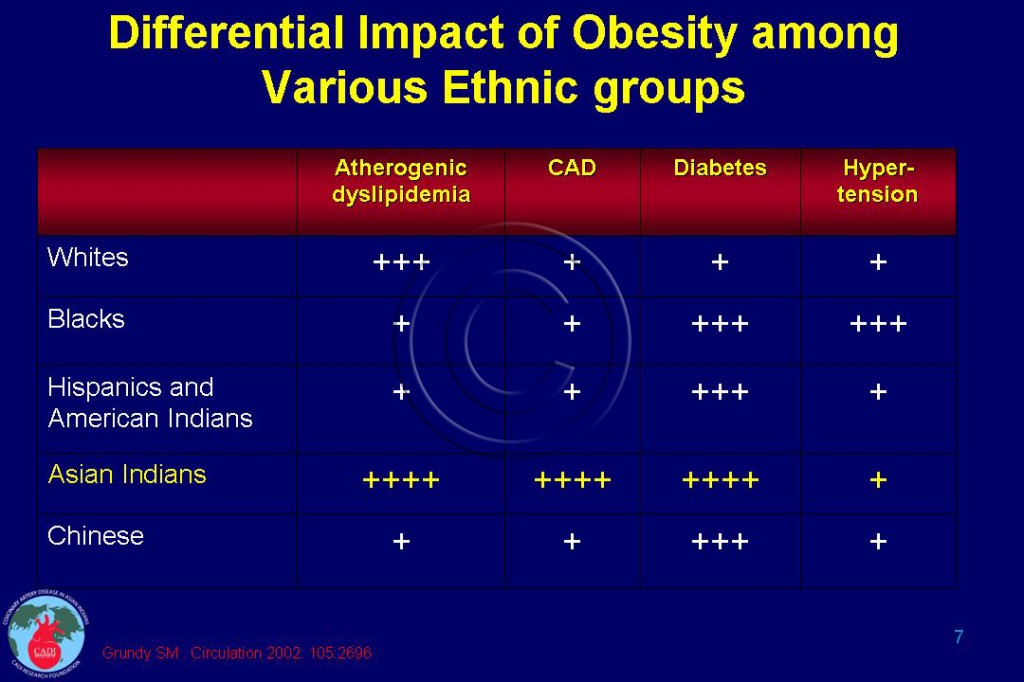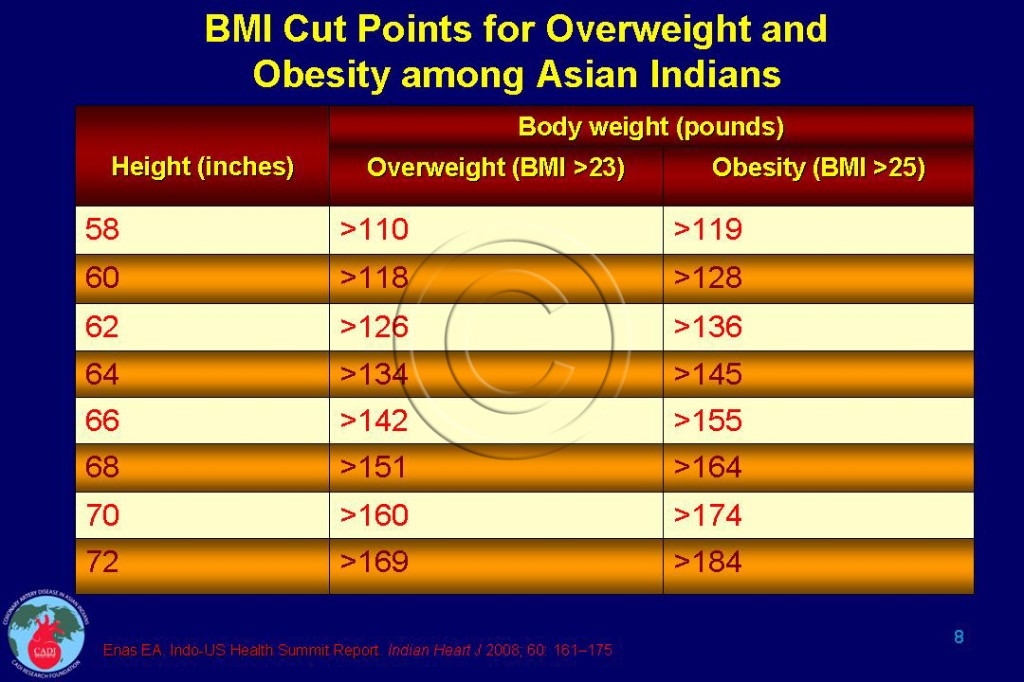Obesity among Asian Indians
- Asian Indians are at high risk for the development of metabolic disturbances, diabetes, atherosclerosis and cardiovascular diseases (CVD) than any other populations at any given body mass index (BMI) ─ the standard measure of obesity (Table 007).1, 2 3
- Obesity is traditionally defined as a percentage body fat of >25% in men and >32% in women. Asians in general and Indians in particular have a greater amount of fat and less muscle mass than whites, for the same weight and BMI.4 Besides, BMI does not accurately predict body fat or cardiometabolic risk among Indians. Hence the use of universal BMI cut-off points is not appropriate for comparison of obesity prevalence between various ethnic groups.4, 5
- Asian Indians have more abdominal (visceral) fat deposition than Europids.4 For the same BMI, percentage body fat is 7-8% points higher for Asian Indians compared to Europids.5
- Conversely, for the same percentage body fat, BMI is 3-6 units lower for Asian Indians compared to Europids. 4-6 The exact opposite occurs in Pacific Islanders and blacks who have 4% points lower percentage body fat than whites for the same BMI.4, 5
- Lean non-diabetic Asian Indians in Singapore had significantly higher body fat percentage (27%) than Chinese (20%) and Europids (23%) matched for age, BMI and physical activity.7 This partially explains the greater adverse metabolic sequelae from obesity for Indians.3
- One Indian study showed that 26% of men had body fat >25% despite having a BMI< 25.8 Other studies from India have shown that the optimum BMI is 21·5 for males and 19·0 for females for identifying people with higher percentage body fat. 9, 10 Another study from South India showed the optimal BMI cut-off point for identifying cardiometabolic risk was 23 in both sexes.11
- Canadian studies have shown that Indians develop glucose and lipid abnormalities at 6 points lower BMI values compared to Europids.12 US studies have shown that at any BMI, Indians in the US have double the prevalence of metabolic syndrome and 3 times the prevalence of diabetes than that of whites (even after fully adjusting for age, sex, education, income, smoking , alcohol use and physical activity).13, 14
- The New Indian guidelines has been released jointly by the health ministry, the Diabetes Foundation of India, the All-India Institute of Medical Science, Indian Council of Medical Research, the National Institute of Nutrition and 20 other health organizations. This has set new, tighter standards for healthy BMI and waist measurement that are consistent with the recommendations of the Indo-US health Summit, WHO and Joint societies. 15-18
- For Asian Indians, the healthy BMI is 23 (kg/m2) for both sexes. A BMI above 23-25 is considered overweight compared to 25 and 30 for Europids. A BMI above > 25 is considered obese among Asians, compared to >30 for Europids.
- A 5’6” Indian, who weighs more than 155 lbs, would be considered obese, compared to 185 lbs, for whites ─ a difference of 30 pounds (Table 008).
- The prevalence of obesity among Asian Indians in the US is 11% using the standard criteria Of but increases to 50% using Asia pacific Indian criteria with another 25% for overweight.19 Both these figures are substantially higher than the US average.
Sources
1. Dhawan J., Bray CL, Warburton R, Ghambhir DS, Morris J. Insulin resistance, high prevalence of diabetes, and cardiovascular risk in immigrant Asians. Genetic or environmental effect? Br Heart J. Nov 1994;72(5):413-421.
2. Deurenberg-Yap M, Chew SK, Lin VF, Tan BY, van Staveren WA, Deurenberg P. Relationships between indices of obesity and its co-morbidities in multi-ethnic Singapore. Int J Obes Relat Metab Disord. 2001;25(10):1554-1562.
3. Grundy SM. Obesity, metabolic syndrome, and coronary atherosclerosis. Circulation. 2002;105(23):2696-2698.
4. Rush E, Plank L, Chandu V, et al. Body size, body composition, and fat distribution: a comparison of young New Zealand men of European, Pacific Island, and Asian Indian ethnicities. N Z Med J. Dec 17 2004;117(1207):U1203.
5. Jackson A. S., Ellis KJ, McFarlin BK, Sailors MH, Bray MS. Body mass index bias in defining obesity of diverse young adults: the Training Intervention and Genetics of Exercise Response (TIGER) study. The British journal of nutrition. Oct 2009;102(7):1084-1090.
6. Deurenberg-Yap M, Chew SK, Deurenberg P. Elevated body fat percentage and cardiovascular risks at low body mass index levels among Singaporean Chinese, Malays and Indians. Obes Rev. Aug 2002;3(3):209-215.
7. Liew C. F., Seah ES, Yeo KP, Lee KO, Wise SD. Lean, nondiabetic Asian Indians have decreased insulin sensitivity and insulin clearance, and raised leptin compared to Caucasians and Chinese subjects. Int J Obes Relat Metab Disord. Jul 2003;27(7):784-789.
8. Misra A., Athiko D, Sharma R, Pandey RM, Khanna N. Non-obese hyperlipidemic Asian northern Indian males have adverse anthropometric profile. Nutr Metab Cardiovasc Dis. Aug 2002;12(4):178-183.
9. Dudeja V, Misra A, Pandey RM, Devina G, Kumar G, Vikram NK. BMI does not accurately predict overweight in Asian Indians in northern India. The British journal of nutrition. 2001;86(1):105-112.
10. Snehalatha C, Viswanathan V, Ramachandran A. Cutoff values for normal anthropometric variables in Asian Indian adults. Diabetes Care. 2003;26(5):1380-1384.
11. Mohan V, Deepa M, Farooq S, Narayan KM, Datta M, Deepa R. Anthropometric cut points for identification of cardiometabolic risk factors in an urban Asian Indian population. Metabolism. Jul 2007;56(7):961-968.
12. Razak F, Anand SS, Shannon H, et al. Defining obesity cut points in a multiethnic population. Circulation. Apr 24 2007;115(16):2111-2118.
13. Palaniappan L P, Wong EC, Shin JJ, Fortmann SP, Lauderdale DS. Asian Americans have greater prevalence of metabolic syndrome despite lower body mass index. International journal of obesity (2005). Aug 3 2010.
14. Lee JW, Brancati FL, Yeh HC. Trends in the Prevalence of Type 2 Diabetes in Asians Versus Whites: Results from the United States National Health Interview Survey, 1997-2008. Diabetes Care. Feb 2011;34(2):353-357.
15. Enas EA, Singh V, Gupta R, Patel R, et al. Recommendations of the Second Indo-US Health Summit for the prevention and control of cardiovascular disease among Asian Indians. Indian heart journal. 2009;61:265-74.
16. Alberti KG, Eckel RH, Grundy SM, et al. Harmonizing the metabolic syndrome: a joint interim statement of the International Diabetes Federation Task Force on Epidemiology and Prevention; National Heart, Lung, and Blood Institute; American Heart Association; World Heart Federation; International Atherosclerosis Society; and international association for the Study of Obesity. Circulation. Oct 20 2009;120(16):1640-1645.
17. WHO/IASO/ITO. Asia Pacific Perspective:Redefing obesity and its treatment World Health Organization, Western Pacific Region;2000.
18. Misra A , Chowbey P, Makkar B. Consensus statement for diagnosis of obesity, abdominal obesity, and metabolic syndrome, for Asian Indians and recomendations for physical activity, medical and surgical management. JAPI. 2009;57:163-170.
19. Misra R, Patel T, Kotha P, et al. Prevalence of diabetes, metabolic syndrome, and cardiovascular risk factors in US Asian Indians: results from a national study. Journal of diabetes and its complications. Mar 18 2009.



